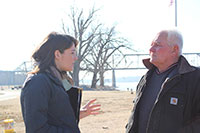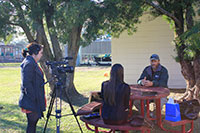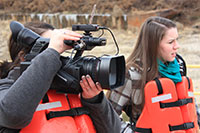
Diving in to “Tapped Out: Unearthing the Global Water Crisis”
For the past year and a half, MediaLab students Haley Huntington, Kortney Scroger, Valery Jorgensen and Katie Baumann have traveled throughout North America documenting the importance of water and perils facing our world’s most important natural resource.
Water does not have feelings. This massive force of nature does not have a conscience. Water does not feel remorse when it washes away entire communities or takes a life. It does not accept the idea that we as humans want water to stay within what we deem to be its safe boundaries. There is no obedience class for a river and no way to persuade water to stay at a certain level or fall from the sky
Throughout history, humans had to adjust around where water was, or face extinction. However, as technology has evolved, the line between what humans can and cannot control is becoming increasingly muddled. Rivers are controlled with dams, levees and other complex forms of engineering. Populations live in locations where, without human manipulation of water, they would otherwise be unable to survive.
Humans are becoming increasingly capable of fending off Mother Nature and doing what works best for industry. Still, there are times when she gets the better of us.
Low water levels along the river have been causing problems for traffic along our nation’s most significant aquatic thoroughfare. The ripple effect from these issues can reach far and wide, on both national and international scales.
We kicked off our trip in St. Louis, MO, examining how the drought that has been plaguing the Midwest this year has impacted industry that operates on the Mississippi River.

St Louis, Missouri
During our months of research leading up to our time in St. Louis, I made contact with the United States Army Corps of Engineers, the governmental organization who has been responsible for the work being done to keep the Mississippi River open and operational.
In and around St. Louis, MO, the Mississippi River has been at an alarmingly low level for months. Caused by a combination of an elongated period of drought and the River’s natural fluctuation during the winter months, these low water levels have inflicted significant issues for industry that operates on the river.
During our time in St. Louis, we visited US Army Corps of Engineers and were able to speak with some incredible individuals. First, we visited the Water Control division who oversee the complex systems that regulate reservoirs and water levels to keep the river operational. That was a mind-boggling experience, trying to keep up with the expiation of everything these experts monitor. To say working in this division of the USACE is full time commitment would be an understatement.

The secondary division of the USACE we were able to spend time with was at the Applied River Engineering Center (AREC) where we saw the astounding manipulations being done to the Mississippi River. These engineering feats are not only improving the efficiency of the river, but are also helping to rebuild and redistribute suitable habitat for the wildlife that populate the area.
With the issues relating to low water in this portion of the Mississippi, barges cannot carry as much weight or they will run aground, the navigational channel is not wide enough to accommodate the typical traffic, tows of barges are being delayed for days. AREC works to prevent problematic delays and shipping concerns.
While the engineers who work at AREC strive for the most permanent solutions possible, with a body of water as dynamic and unpredictable as the Mississippi sometime immediate fixes must be employed. One such solution is dredging, or the pumping of sediment out of the navigational channel of the river and relocating it to the sides of the river. In some areas dredging, or the digging out of sediment sitting at the bottom of the river channel, has been going on day and night for more than half a year.
Over time, this sediment makes its way back into the channel due to natural erosion. Consequently, consistent river engineering is necessary to keep the waterway fully operational.
We were able to spend an afternoon on the Dredge Potter, the vessel who had been fully operational 24/7 for more than half a year as of January 2013. Seeing the amount of work being done to keep the river open and fully operational drastically put the issues that waterway is experiencing into perspective.
One of the most impressive realizations I took away from our time with the USACE is how serious of a ripple effect the problems being experienced on the Mississippi River can have on our bustling nation.
If the river were to shut down, somewhere around $45 million would be lost daily. The impacts of a river closure would reach far and wide. A typical barge carries as much cargo as 70 or more semi trucks. If barge tows are unable to operate on the river, the goods they would otherwise transport must be delivered from point A to point B and would be placed on trucks. As a result, roadways would experience a significantly higher saturation of large semi trucks that would slow traffic, damage infrastructure, increase the consumption of fossil fuels, and release additional pollutants into the air. Gasoline prices would rise, causing trucking companies to charge more for their services. Farmers and agriculture industry would then have to react by also raising prices, causing the cost of food to escalate around the country, and possibly worldwide. The impacts of a river closure would not stop there, but would continue to ripple through society.
Heading South
Saying our goodbyes to St. Louis, we piled into our trusty rental mini van, nicknamed “Starship Enterprise,” and headed south. Our end destination was New Orleans, LA, only a mere 14 hours south of where we were. Along the way, however, we had a couple of stops to make.
The first was Thebes, IL, where an impressive amount of river construction was going on. The river’s low levels had revealed sheets of rock along the river bottom that were causing issues for passing vessels. To mitigate the issue, the USACE developed a plan to remove the rock via controlled explosions along the river bottom and dredge out the rubble to add a foot and a half of depth in order to keep the river operational until spring rains.
In Thebes, we spoke with local history expert and owner of Thebes Landing: Trailer park and campground, Neal Day. He explained how the river construction had impacted the small community, which as very minimally. What I found even more interesting were Day’s thoughts and memories on how the river itself had influenced Thebes and surrounding communities.
Day’s point that resonated with each member of the documentary team was that water does not care about anyone or anything. It is a force of nature with no continence. Disasters caused by water are not done out of malice, but are simply nature acting as it should: Naturally.
When asked if he thought humans should stop intervening in nature by manipulating the Mississippi, Day shook his head. He said that it was too late. There are too many things that rely on the river to remove human influence.
It was becoming increasingly clear that, as far as the Mississippi River was concerned, as a society, we have come too far with our technological advancements to ever go back. After this explanation, I remember thinking to myself there’s that ripple effect again.

Saying thank you to Neal Day and Thebes Landing, we hopped back in the mini van and continued to Cairo, IL, a town several miles south. Cairo had experienced devastating flooding some years ago and had never fully recovered. Driving through this run-down community, Day’s assertions that water does not care what happens when it escapes the river’s banks.
Stopping only to grab some quick b-roll, we powered through Cairo and on to New Orleans. With an interview early the next morning we spent the drive drafting questions, reviewing previous interviews and sorting out the stories we had collected so far. The feeling was mutual: This project is going to be incredible.
New Orleans, LA
In New Orleans, our interview schedule was full once again. Starting off, we met with the USACE in New Orleans to discuss how low water levels had been impacting the city’s fresh water supply. Incidentally, as their colleagues upstream dealt with low water problems, downstream the shrinking fresh water was causing stress as well.
With receding freshwater, saltwater from the Gulf was creeping up the river channel, getting dangerously close to the pipes that draw drinking water for the city and surrounding areas.
However, in a moment of engineering genius, Chris Accardo from the USACE explained to me in his interview that they had set out to build an underwater sill, or wall, that would keep the dense and dangerous saltwater away from the city’s fresh water supply. This underwater wall was resourcefully built from previously dredged material from upstream and would wash away as spring rains came and replenished the river.
Crisis averted, the people of New Orleans can continue to breathe easy that their drinking water is safe. However, after looking at the heavily trafficked waterway from which their water is drawn from, each of us could agree that we would still think twice about drinking out of the tap. After all, we were told in St. Louis that, by the time the water in New Orleans reached the city, it had been used an average of 26 times.
In this part of the country, there are problems beyond the Mississippi waiting to be explored as well. One such issue is that of wetland disappearance along the Louisiana coastline.
Collectively, Louisiana is losing football field sized chunks of wetlands an hour. With the amount of human intervention along the Mississippi River preventing seemingly harmful flooding, wetlands are unable to rebuild themselves with the river nutrient rich silt that would otherwise be deposited as river waters escaped their banks. Being overcome with saltwater, these vital portions of land are disappearing at alarming rates. There is that interconnectedness again.
We spoke with Matt Rota of the Gulf Restoration Network and Andrew Barron of the Barataria-Terrebonne National Estuary Program who both explained why we should be aware of this dissipating resource. With New Orleans sitting below sea level, catastrophic storms, such as Katrina in 2005, wreak havoc. So why would we not protect what could protect us?
Wetlands act as a buffer for hurricanes and other tropical storms coming off the Gulf, decreasing their intensity and potential damage. However, as these wetlands disappear, as do their beneficial qualities.
Wrapping up our travels, my mind was buzzing with questions. How do we fix these problems? What happens if they persist? Are there any permanent solutions? And, if not, how will humans adapt to eminent changes?
While only time will truly be able to answer those fully, I am hoping that as the documentary team continues research and production of “Tapped Out,” we will be able to shed light on some promising solutions as well.


